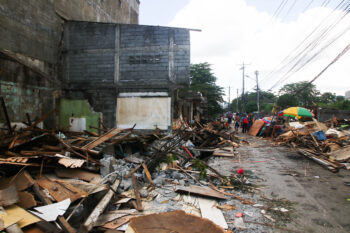by Engr. Zamzamin Lumenda Piang Ampatuan
RAJAH BUAYAN, Maguindanao (MindaNews/09 September) — The proposed 300-megawatt coal-fired power plant in Binugao District, Davao City is a laudable project if only to address the power shortage in Mindanao which at present has reached disturbing levels. By 2014, when the Aboitiz Power Corporation (APC) would not have completed this large power plant, Mindanao would be in much pain trying to cope up with its 484 megawatts power needs. The urgency of completing this project is quite obvious. Each day of delay in completing planned new power plants spells the negative impact on the growth prospect of not only Davao City but the whole of Mindanao.
Of course, the environmental and resource-management issue could not be simply shelved. The concern of Vice Mayor Rodrigo Duterte about the use of fresh water instead of seawater deserves attention. The points raised by environmental advocacy groups should also be taken into consideration. But all these discussions on the pros and cons of putting-up a coal-fired power plant should not blur our perception of the current problem at hand, that is, Mindanao is on the brink of a more serious power crisis.
To address the issue raised by Vice Mayor Duterte on the use of water, there are key points to be considered which probably the Aboitiz Power Corporation has taken care of. First point is the use of water for the steam cycle process and second is for cooling down the heat discharge of combustion gases in coal-firing. Use of water is necessary for the steam cycle process, and it has to be clean and fairly pure, which implies that fresh water from open or ground source would be almost inevitable. Only a very small amount of make-up water is required in the steam cycle heat transfer. Hardly any loss of water volume occurs in the closed loop steam cycle.
What would be alarming is the use of large volume of water to cool the system so as to condense the low-pressure steam and recycle it. As the steam in the internal circuit condenses back to water, the surplus heat which is removed from it needs to be discharged by transfer to the air or to a body of water.
As the proponent of this power plant project have probably found out, locating where there is good source of fresh water and being close to the sea is quite strategic because it might be that they intend to use both — clean and fairly pure ground water for the steaming process and seawater for the cooling process.
APC may have thought about the cheapest cooling technology and that it intended to use direct or “once-through” cooling which involves running a large volume of water.
If APC intends to use seawater for the cooling process and fresh ground water for the steaming process, then the issue raised by Vice Mayor Duterte would have been addressed. To adopt a stern position that the power plant would have to use seawater for steaming would make the project cost run very high as this would require putting-up a another plant to convert seawater into fresh, clean and fairly pure water. APC would have to restructure its project financing and may have to seek higher tariff to make the project feasible.
Another way of addressing the use of water if it altogether has to be addressed is to ask APC if it would be willing to adopt “cooling towers,” a technology referred to as “re-circulating or indirect cooling” or it would be using “dry cooling” which does not use water at all. Both technologies are quite expensive and would again call for further financial re-evaluation of the coal power plant.
The environmental concerns will always hang crossing the path of any industrial project. In this case, a coal-fired power plant, is known for its high carbon emission. The assurance given by APC on the issue of greenhouse emissions saying that this project is a “new generation circulating fluidized bed which will significantly reduce emissions”, hopefully have convinced the environmental protection advocacy groups. The long-way to address carbon emission in coal-firing systems is to install “carbon-capture and storage” or CCS which will make APC outrightly abandon this much needed project.
At the moment, the Philippines has very limited option to generate power and propel its economy. The source for renewable energy for electricity generation is vast but is not practical for poor countries given major economic costs. Generating power using renewable energy is on average twice as expensive from the most economical technology using fossil-fuel and triple the cost of surplus electricity. Solar power for bulk generation is most uneconomical followed by biomass, hydroelectric and geothermal. Windpower generation is almost economically irrational.
The cost-benefit issue in terms of the technology to be used by APC to give weight to the complains about the use of water to put-up the 300-megawatt power plant may be a taxing one. At the tune of P25 Billion, the APC may have exerted painstaking effort at seeking funding for this biggest single investment ever in Mindanao. Taking into consideration the resource management and environmental issue of putting-up a coal fired power plant may lead to the shelving of the project. Where then will Mindanao get its power requirements and feed its expanding economy?
Vice Mayor Duterte has expressed quite well his worry about slowing down the project implementation, saying, “I am sorry to delay the project but there are things that need to be addressed.” Hopefully, it does not get too long to address the legitimate issues and that the illogical points against the project would not get in the way so that the project will not end up in the shelves of Aboitiz Power Corporation.
When discussing this issue, think about the poor, the unemployed, the new graduates who would be seeking jobs — where will they earn a living if Davao and Mindanao are not able to grow because of power shortage? To cut it short, where there is no power, there will be dark days ahead — brownouts and poverty. (MindaViews is the opinion section of MindaNews. Engr. Zamzamin Lumenda Piang Ampatuan served as Energy Undersecretary under the Arroyo administration).






